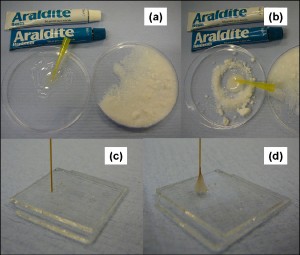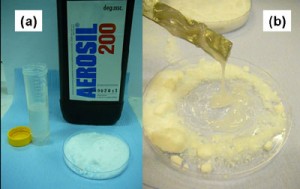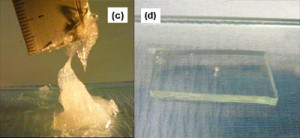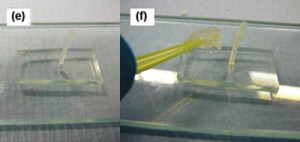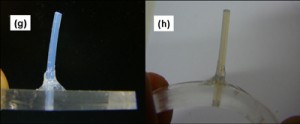Alexander Iles
Dept. Chemistry, University of Hull, Cottingham Rd, Hull, HU6 7RX, UK
Problem
In microfluidics it is often necessary to interface chips using capillaries or plastic tubing. This can introduce a number of problems. For example, with glass chips it is rarely the case that the tubing or capillary is a perfect match for the reservoir hole that has been drilled into the device. Hence when using adhesives to attach tubing, the glue can seep down into the microdevice and clog its channels. Alternatively, with PDMS it is difficult to find anything that will stick to it and also securely hold a connecting tube in place. Nanoports can be used to interface devices, but they are expensive [1]. Small pieces of PDMS can be plasma bonded to a chip to create ports [2], but this involves extra fabrication steps and a plasma oven.
The solution:
To use fumed silica to create thixotropic adhesives. Adding fumed silica to epoxy resins or to PDMS creates adhesives that are extremely viscous and will not flow. Hence it can be added to epoxy resins to prevent seepage between access holes and tubing with glass chips and also it can be added to PDMS to make highly effective ports for PDMS chips.
Materials
- A small quantity of premixed epoxy resin or PDMS
- Fumed silica. Fumed silica is manufactured by Degussa and can be obtained as a free sample by visiting their website[3]
- A container and a spatula for mixing
Procedure
1. Take a small quantity of your resin of choice (epoxy or PDMS). Place this in your mixing container.
2. To the resin, add a small amount of fumed silica, and using a spatula, mix it into the resin. A good starting point is 1 part fumed silica to 11 parts pre-mixed PDMS (by weight). Warning! Always wear a dust mask when handling fumed silica, it is like very fine dust. One sneeze and it will go everywhere! Bear in mind the working life of your epoxy resin, some resins set in 5 minutes or less, which will not give much time for mixing in fumed silica.
3. Once the fumed silica has been incorporated into the resin, add more as necessary to obtain the required thixotropy. Then it is ready for application.
4. For glass chips, always wipe down the surface of the device with acetone and allow it to evaporate before applying epoxy, to ensure a good bond.
5. Place the tube or capillary into the hole. Use a pipette tip or small applicator to apply a small blob of adhesive around the interface. The resin mixture will not flow, so it will be necessary to smooth it around the tube or capillary with the applicator. The procedure is similar for PDMS devices, except that a hole must first be bored into the chip, the tube inserted and then the thixotropic PDMS applied. In both cases, cure times can be reduced and adhesion strengths improved if an oven at 60-70 ºC is used for curing. Refer to Figures 1 and 2 for step by step photographic explanations and further details.
Figure 1. Procedure for making thixotropic epoxy for interfacing glass chips: (a) Mix the epoxy in a suitable container and have some fumed silica ready for use. (b) Add the fumed silica and mix in. (c) Insert a capillary or tube into a hole on the glass chip, after wiping it with acetone. (d) Apply thixotropic epoxy to the interface between the chip and the connector and leave to cure.
Figure 2. Procedure for making thixotropic PDMS for interfacing PDMS chips: (a) Mix the PDMS in a suitable container and have some fumed silica ready for use. (b) Add the fumed silica and mix in. (c) The PDMS should now look like this. (d) Cut a hole using a boring tool in your PDMS chip. (e) Insert a tube (e.g. PTFE) of a suitable size into the hole on the PDMS chip. (f) Apply thixotropic PDMS to the interface between the chip and the connector tube. (g) Leave it to cure, either at room temperature or at 60-70 ºC. (h) The completed interface. A silica capillary from, for example, a syringe pump, can now be securely inserted into the PTFE tubing and removed again as often as required without leaking. The PTFE tubing has an I.D. of 300 µm, which makes a good interference fit with standard 375 µm O.D. silica capillaries.
Conclusion
Adding fumed silica to PDMS or epoxy resins allows the researcher to fine tune the viscosity of their system as desired. Thixotropic PDMS is probably one of the best materials for interfacing PDMS devices, since few things will stick better to PDMS than PDMS itself!
References
[1] C. Koch, J. Ingle, and V. Remcho, Bonding Upchurch® NanoPorts to PDMS, Chips & Tips (Lab on a Chip), 12 February 2008.
[2] S. Mohanty, D. J. Beebe and G. Mensing, PDMS connectors for macro to microfluidic interfacing, Chips & Tips (Lab on a Chip), 23 October 2006.


